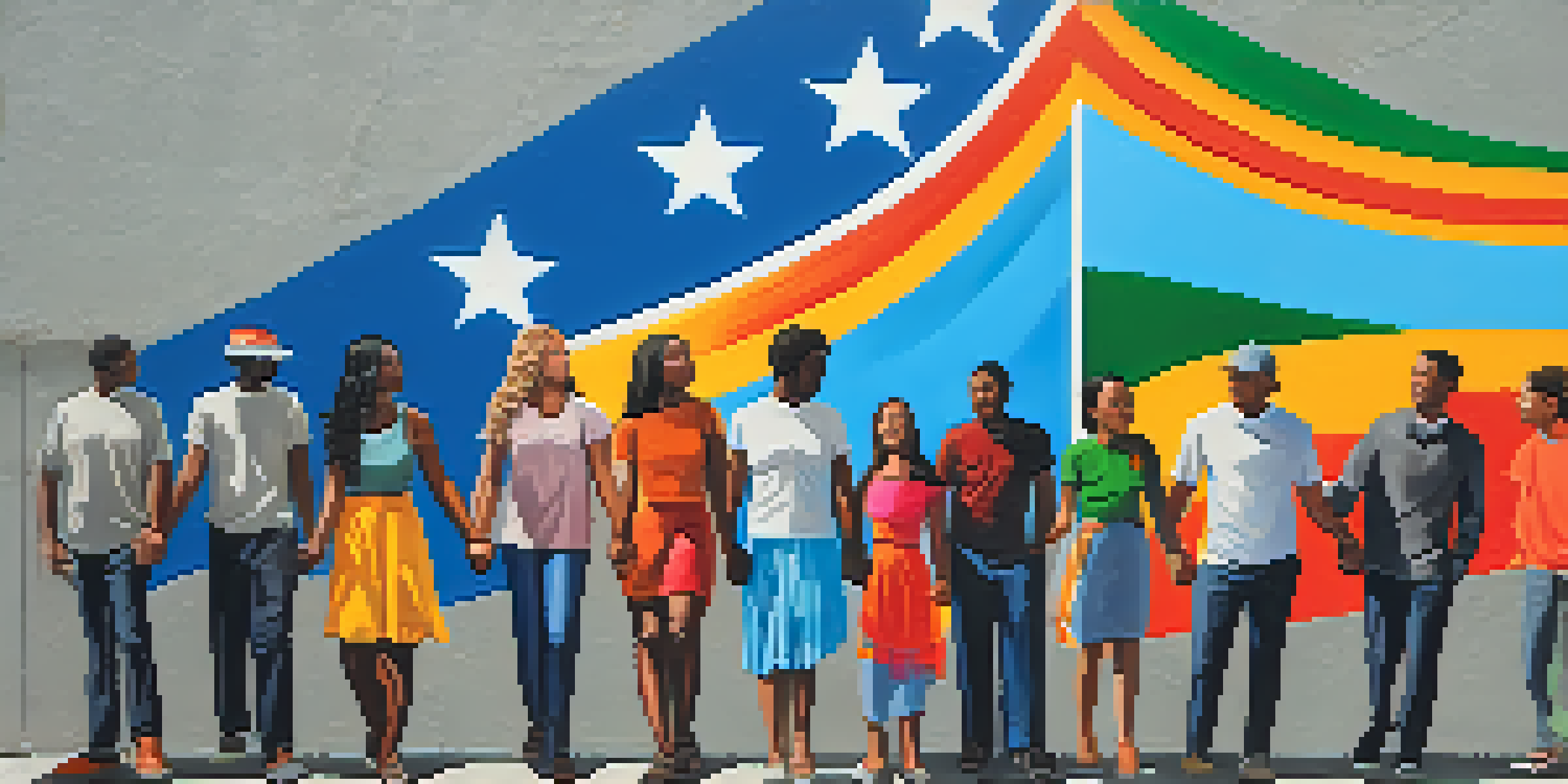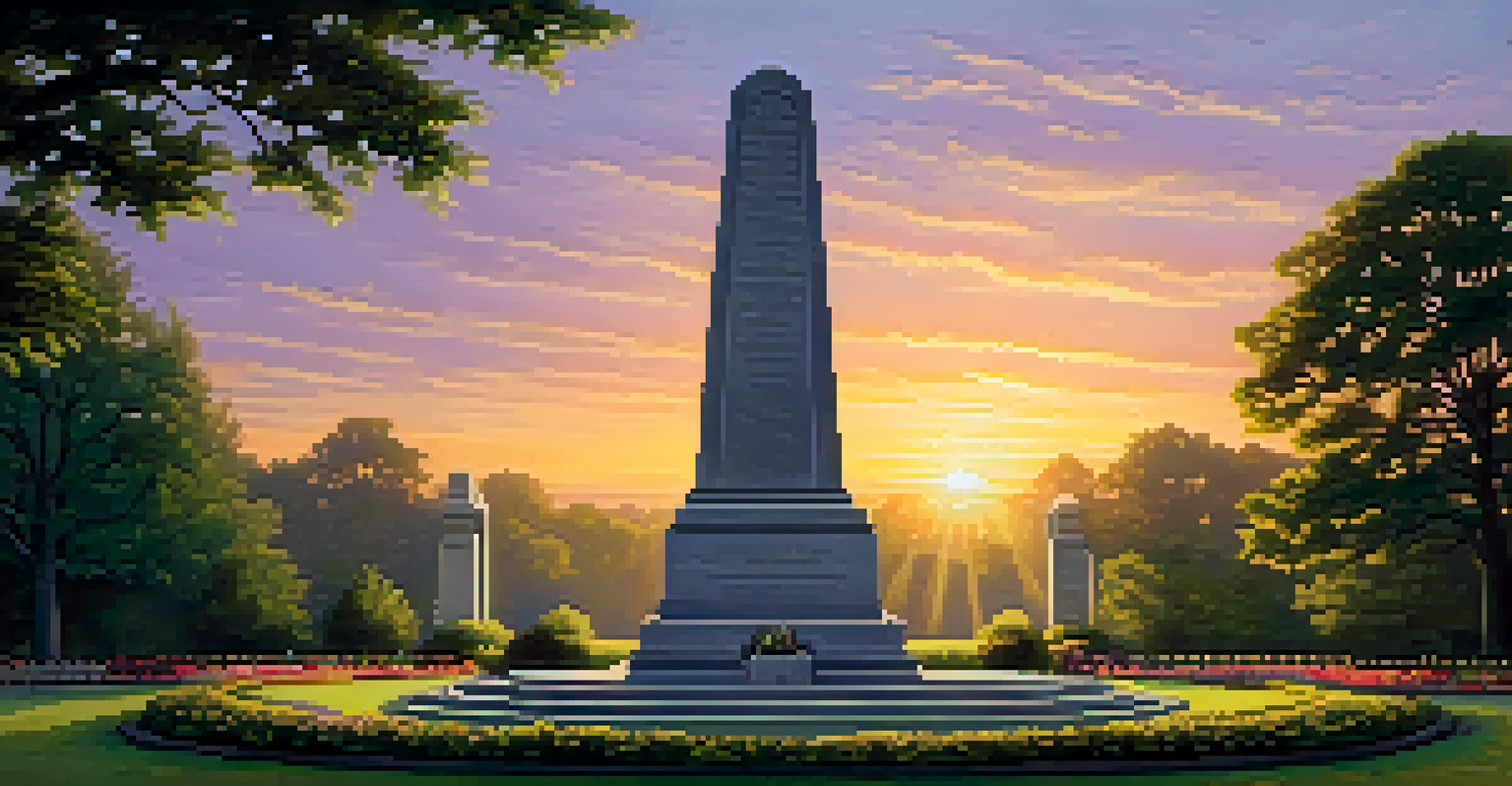The Impact of War on Artistic Expression Through History

War's Catalyst Role in Artistic Movements
Throughout history, war has often acted as a catalyst for artistic movements. Artists have used their craft to reflect the chaos and emotional turmoil of conflict, leading to new styles and genres. For instance, the devastation of World War I gave rise to Dadaism, a movement that embraced absurdity and rejected traditional aesthetics.
Art is the most beautiful of all lies.
This rejection of norms allowed artists to express their disillusionment with society. Similarly, the Surrealist movement emerged, utilizing dreamlike imagery to explore the subconscious affected by war's horrors. The interplay between conflict and creativity reveals how adversity can spur innovation in the arts.
Ultimately, war generates a unique environment that challenges artists to respond, often resulting in groundbreaking works that resonate with the human experience. These movements remind us that even in the darkest times, creativity can flourish and provide a voice for the voiceless.
Art as Propaganda: A Double-Edged Sword
War has historically been a tool for propaganda, where art plays a crucial role in shaping public perception. Governments have commissioned artists to create pieces that glorify military efforts or demonize the enemy. For instance, during World War II, posters featuring bold imagery encouraged enlistment and boosted morale among civilians.

However, this use of art can often blur ethical lines, as it may manipulate emotions and promote nationalistic fervor. While some artists embrace this role, others resist, using their work to critique the very narratives being promoted. This dichotomy illustrates the complex relationship between art and power during wartime.
War Fuels Artistic Innovation
Throughout history, war has catalyzed artistic movements, prompting artists to create innovative works that reflect the chaos and emotional turmoil of conflict.
Ultimately, art as propaganda serves to highlight the multifaceted ways in which creativity can be utilized for both unifying and divisive purposes. It reinforces the idea that artistic expression can be a powerful weapon in the arsenal of war, for better or worse.
The Influence of Trauma on Artistic Expression
The impact of war often leaves deep psychological scars on those involved, and this trauma frequently finds its way into artistic expression. Many artists who have experienced conflict firsthand channel their pain into their work, creating pieces that convey the raw emotions of their experiences. For example, war veterans have painted and written about their struggles, providing insight into the realities of combat.
The artist's job is not to succumb to despair but to find an antidote for the emptiness of existence.
This art becomes a form of therapy, allowing both the creator and the audience to process grief, loss, and trauma. It serves as a reminder of the human cost of conflict, often evoking empathy and understanding from viewers. Through this lens, art becomes a bridge between the personal and the universal.
Moreover, the themes of loss and suffering resonate across cultures and time periods, highlighting the shared human experience of war. As such, trauma-infused art can foster connections that transcend geographical and temporal boundaries, reminding us of our collective resilience.
Art as a Tool for Resistance and Change
Art has long served as a means of resistance against oppression, especially in times of war. Artists often use their platforms to challenge the status quo, bravely confronting injustices and advocating for change. For instance, during the Vietnam War, musicians and visual artists created powerful works that protested the conflict and questioned its morality.
This spirit of defiance can manifest in various forms, from protest songs to graffiti that adorns city walls. Such expressions not only critique the war but also inspire others to join the fight for justice. In this way, art transcends mere aesthetics, becoming a rallying cry for those seeking to enact change.
Art as a Tool for Resistance
Artists have used their work as a means of resistance during wartime, challenging injustices and inspiring societal change through powerful expressions.
Ultimately, the role of art in resistance demonstrates its potential to influence societal perceptions and inspire movements. It reminds us that even in the face of adversity, creativity can empower individuals to stand up for their beliefs and advocate for a better world.
The Evolution of Artistic Styles During War
As wars evolve, so too do the styles and mediums of artistic expression. Each conflict brings unique circumstances that shape how artists respond, leading to the emergence of new techniques and themes. For example, the rise of photography during the Civil War provided a stark, realistic portrayal of battle that previous art forms could not convey.
This shift not only changed how war was documented but also influenced how people perceived its impact. Additionally, modern conflicts have seen the rise of digital art and social media, allowing artists to share their messages instantaneously with a global audience. This evolution reflects not only technological advancements but also changing societal attitudes toward war.
In examining these shifts, we see a dynamic interplay between war and artistic expression that continues to evolve. Art remains a vital lens through which we can understand the complexities and consequences of conflict across generations.
Cultural Responses to War Through Art
Different cultures have unique ways of processing and responding to war through art. While some may focus on the glorification of heroism, others might delve into themes of loss and mourning. For instance, the Japanese art form of 'Ikebana' often reflects the transient nature of life, echoing sentiments of loss stemming from World War II.
These cultural responses serve to preserve collective memories and histories, allowing future generations to engage with their past. They also highlight the diversity of perspectives on war, revealing how various societies interpret and express their experiences through artistic means. This rich tapestry of responses fosters a deeper understanding of the complexities of conflict.
Cultural Perspectives on War
Different cultures respond to war through unique artistic expressions, preserving collective memories and fostering empathy across diverse societies.
Ultimately, cultural expressions of war through art remind us that while experiences may differ, the emotions they evoke resonate universally. Art acts as a powerful medium for cross-cultural dialogue, bridging gaps and fostering empathy among diverse audiences.
The Role of Women in War-Inspired Art
Historically, women's contributions to art during wartime have been both profound and underappreciated. Women artists have often used their work to comment on the human experience of war, frequently focusing on themes of loss, resilience, and peace. For example, artists like Käthe Kollwitz produced haunting pieces that captured the grief and suffering caused by war.
These contributions challenge the traditional narrative of war art, which has often been dominated by male perspectives. By exploring women's experiences and viewpoints, we gain a more nuanced understanding of the impact of conflict on society. Their voices bring attention to issues often overlooked in mainstream art and history.

Recognizing the role of women in war-inspired art enriches our appreciation for the diversity of artistic expression. It emphasizes the need for inclusive narratives that reflect the full spectrum of experiences shaped by war, fostering greater understanding and empathy.
Art's Enduring Legacy in the Wake of War
The legacy of war on artistic expression is enduring, with artworks serving as poignant reminders of the past. These pieces often evoke powerful emotions and provoke thought, ensuring that the lessons of history are not forgotten. For instance, memorials and monuments created in the aftermath of conflicts serve both as tributes and calls for reflection.
Art continues to play a crucial role in the healing process for individuals and communities affected by war. Through exhibitions and public installations, artists facilitate conversations about trauma, memory, and reconciliation. This ongoing dialogue is essential for fostering understanding and preventing the repetition of past mistakes.
Ultimately, the impact of war on art transcends time, creating a legacy that influences future generations. As we engage with these works, we honor the sacrifices made and confront the complexities of human conflict, ensuring that the stories of those affected by war continue to resonate.